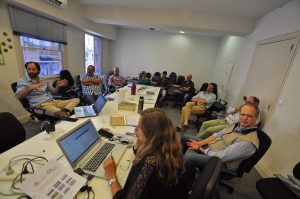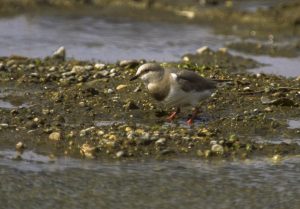Participatory Process Begins to Create National Shorebird Conservation Plan in Argentina
In March 2016, in the tourist town of Las Grutas, Argentina, key actors and conservation stakeholders came together from across the country for a workshop called “Argentina’s Importance to Migratory Shorebirds on the Atlantic Flyway.” The workshop addressed national opportunities and challenges in terms of projects, participation and coordination that align with the Atlantic Flyway Shorebird Initiative. One proposal that emerged from this workshop was that a national planning process would be needed to effectively conserve shorebirds and their habitats in Argentina.
In July 2018, the WHSRN Executive Office reached an agreement with the Government Secretariat of the Environment and Sustainable Development to join forces and launch a participatory process to create the Argentine National Shorebird Conservation Plan. And now, in spring 2019, the process is officially underway. The first milestone took place in early April in Buenos Aires, with the first meeting of the Technical-Advisory Committee, whose role is to provide strategic guidance during the process of building the plan. This Committee is composed of representatives of Argentina’s Secretariat of the Environment and Sustainable Development, non-profits Aves Argentinas and Fundación Humedales-Wetlands International, and the WHSRN Argentine Council and WHSRN Executive Office.
This first work session in Buenos Aires was co-facilitated by Maricel Giaccardi, an expert planning consultant, and WHSRN Conservation Specialist Diego Luna Quevedo. Together with the Committee, they discussed and adjusted methods for preparing the plan, established the content and scope of the plan (including criteria for site prioritization), identified key actors, and agreed upon a mechanism to formalize the plan. The next steps in this participatory process will include two national workshops, one in June and the other in September of this year.
Coordinated by WHSRN and its partners in Argentina, this initiative will generate a national framework to mobilize diverse actors in Argentina, from the public and private sectors, academia, and civil society. The effort seeks to increase and strengthen local capacity for shorebird conservation action at the national, provincial and local levels.
In addition to the ongoing process in Argentina, the WHSRN Executive Office has also been facilitating the design and implementation of national shorebird conservation plans in Brazil and Ecuador, and is currently beginning a similar process in Peru.
For more information on the national shorebird conservation planning process in Argentina, contact Diego Luna Quevedo, WHSRN Conservation Specialist, Manomet Inc. / diego.luna@manomet.org.
Plan Argentino de Conservación de Aves Playeras inicia proceso participativo
Durante marzo 2016, se llevó a cabo en la ciudad turística de Las Grutas, el taller “Argentina en la Ruta Migratoria de las Aves Playeras del Atlántico” que convocó actores clave e interesados directos en conservación de diversos puntos del país. Se abordaron oportunidades y desafíos nacionales en términos de proyectos, participación y articulación en el marco de la iniciativa del Atlántico. Uno de las propuestas surgidas de este taller fue la necesidad de avanzar en un proceso de planificación nacional para la conservación efectiva de las aves playeras y sus hábitats.
Durante julio 2018, la Oficina Ejecutiva de la RHRAP alcanzó un acuerdo con la Secretaría de Gobierno de Ambiente y Desarrollo Sustentable para articular esfuerzos y poner en marcha un proceso participativo para la construcción del Plan Argentino para Conservación de Aves Playeras. El hito de inicio de este proceso se llevó a cabo la primera semana de abril en Buenos Aires, con la primera reunión del Comité Asesor-Técnico, que tiene como rol brindar orientación estratégica al proceso de construcción del plan. Dicho Comité está integrado por representantes de la mencionada Secretaría de Gobierno de Ambiente y Desarrollo Sustentable, Aves Argentinas, Fundación Humedales-Wetlands International, Consejo Argentino y Oficina Ejecutiva RHRAP.
La primera sesión de trabajo en la ciudad de Buenos Aires fue co-facilitada por la consultora experta en planes Maricel Giaccardi y el Especialista en Conservación de la RHRAP, Diego Luna Quevedo. Entre otros aspectos se presentaron y ajustaron aspectos metodológicos del proceso de elaboración del plan, se establecieron contenidos y alcances (incluyendo criterios para priorización de sitios) se identificaron actores clave y se acordó un mecanismo para la oficialización del plan. Como parte del proceso participativo de construcción del plan, se llevarán a cabo dos talleres nacionales, uno en junio y otro en septiembre de este año.
Este iniciativa articulada por la RHRAP y sus socios en Argentina permitirá generar un marco nacional para movilizar a diversos actores y sectores; sean públicos, privados, academia y sociedad civil. Se busca aumentar y fortalecer la capacidad de acción en conservación de aves playeras, tanto a nivel nacional, provincial como local.
Además del proceso en Argentina, la Oficina Ejecutiva de la RHRAP ha venido facilitando proceso participativos para el diseño y puesta en marcha de planes nacionales en Brasil y Ecuador y actualmente se avanza en un proceso similar en Perú.
Por más información sobre este proceso de planificación de la conservación de aves playeras a escala nacional en Argentina, contacte a Diego Luna Quevedo, Especialista en Conservación de la RHRAP, Manomet Inc. / diego.luna@manomet.org.



